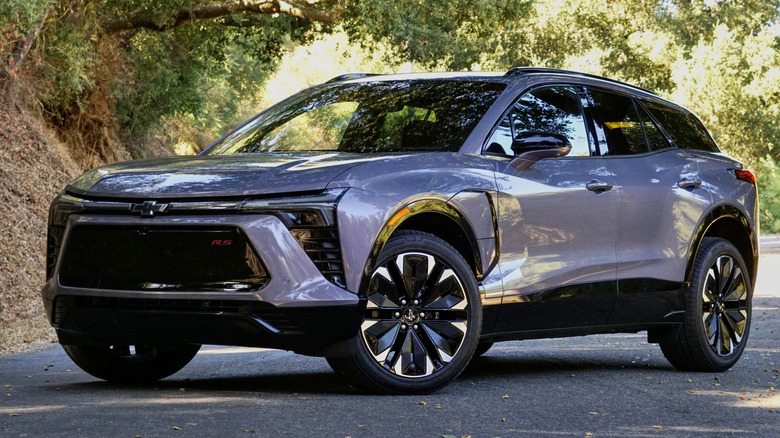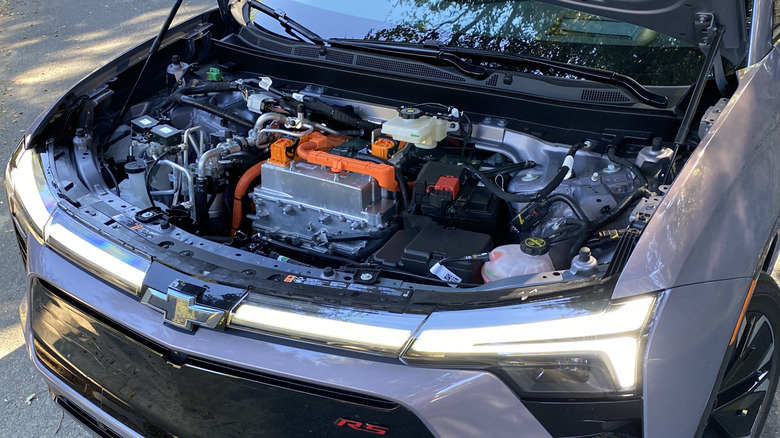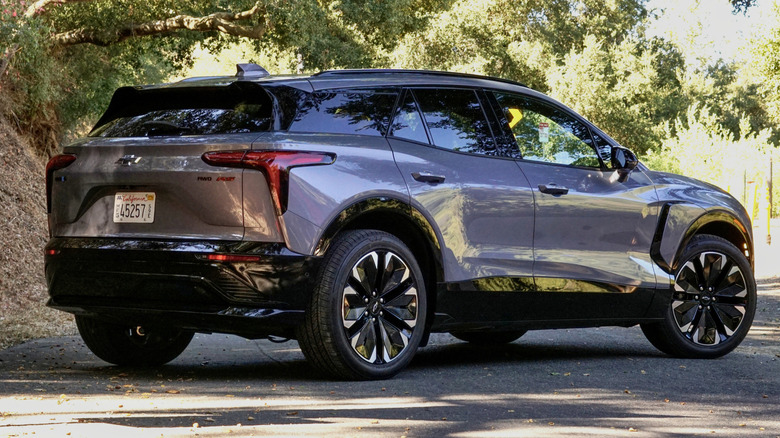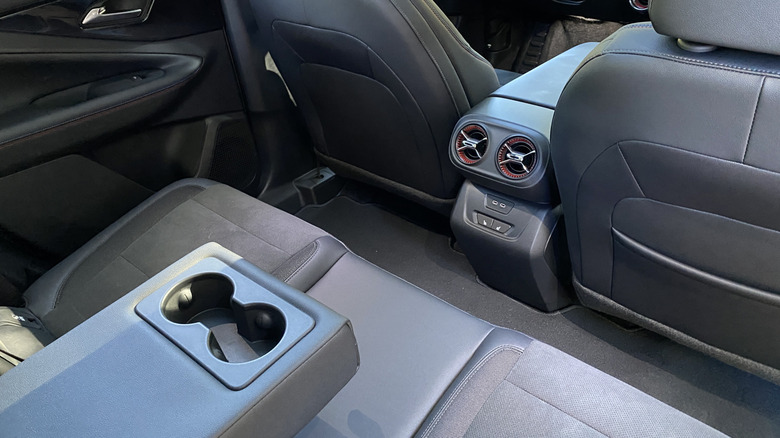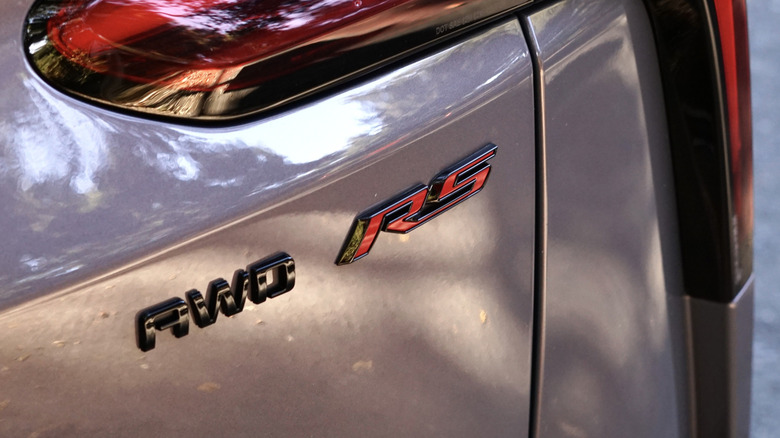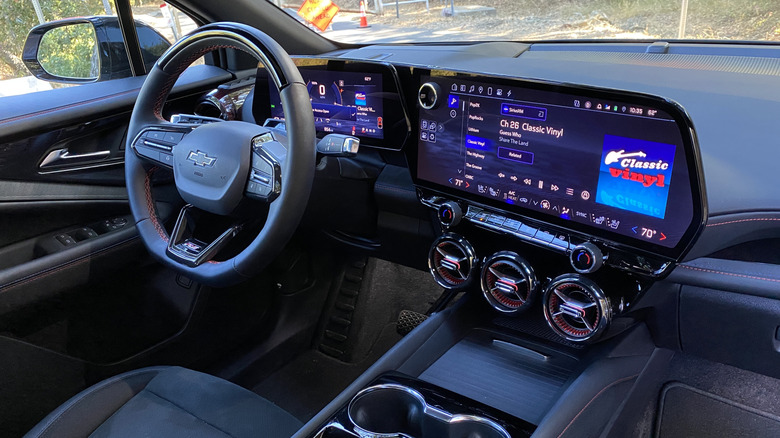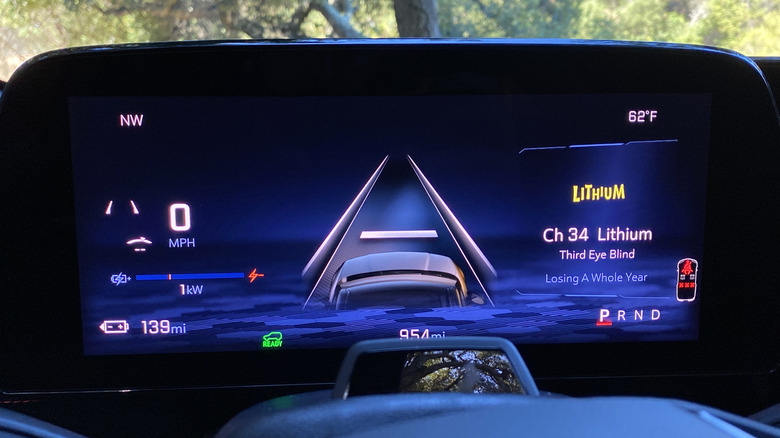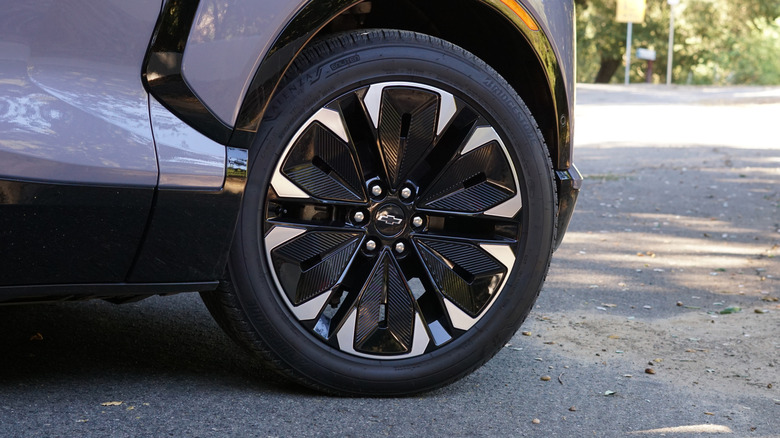2025 Chevrolet Blazer EV Review: Impressive Range, Frustrating Dashboard
- Spacious cabin for passengers
- Impressive range on rear-drive models
- Super Cruise is an excellent available driver aid
- No Apple CarPlay or Android Auto
- High price on upper trim levels
- Big exterior dimensions don't translate to cargo space
The 2025 Chevrolet Blazer EV has a lot to offer. An all-electric SUV with two rows of seating and a respectable range estimate, it's one of a growing number of options for families looking to ditch gasoline. There are multiple trim levels spanning a wide breadth of price points, different range ratings for different configurations, and even a high-horsepower SS model on the horizon that could challenge some of the most powerful EV's in the class. The interior is spacious, there's a lot of modern tech on the inside, and the styling is pretty sleek.
It's not all positives though, especially when it comes to the Blazer EV's size and price. Large exterior dimensions give the Blazer EV lots of room for passengers, but cargo space is only average for the class. As for the price, there's some notable equipment that's missing from the options sheet, most conspicuously Apple CarPlay and Android Auto. Daily driving the 2025 Chevrolet Blazer EV however, is relatively easy and enjoyable and there are a number of features that help distinguish it from the rapidly expanding number of available electric SUVs.
Power and performance choices
Currently, there are two different battery choices for the Blazer EV: an 85 kWh battery for all-wheel-drive models, and a 102 kWh battery for rear-wheel-drive models. Official range estimates for the 2025 Blazer EV are only in for all-wheel drive models, with the EPA estimating 283 miles of travel on a full charge. Chevrolet's rear-wheel drive estimates are significantly higher, the larger battery pushing it to 334 miles on a single charge.
Power ratings change significantly depending on which layout you select, too. All-wheel drive Blazer EVs produce 288 horsepower and 333 lb-ft of torque, while rear-drive models with their bigger battery packs make 340 horsepower and 325 lb-ft of torque. It isn't the most powerful or fastest version of the Blazer EV, but the all-wheel-drive RS trim level that I tested provided quick acceleration and felt more than powerful enough to make passes on the highway. Unless you're looking for hot-rod vibes with your EV, it's plenty sufficient. For those still demanding more, Chevy has been promising a top-of-the-line 557-horsepower SS model for quite some time now, but it's still yet to arrive.
According to Chevy, charging on a 240-volt charger will add 21-31 miles of range per hour, which is average for the segment. A DC fast charger can add as much as 68 miles of range in 10 minutes on all-wheel drive Blazer EVs, or up to 80 miles of range in 10 minutes for rear-drive models; that's also on par with the competition.
Feels big because it is big
The Blazer EV is large. It may be a two-row SUV, but it has exterior dimensions that could easily be mistaken for a modest three-row SUV. At 78 inches wide (not counting the mirrors) it's only 3 inches narrower than a Suburban or Tahoe. At 192.2 inches long, the Blazer EV is 2 inches longer than the three-row Hyundai Santa Fe and only 5 inches shorter than the Kia EV9 – a spacious (and hardly small) three-row SUV.
In practice, this means finding the edges of the large Blazer EV from the inside is difficult, as visibility is limited with the long hood and the large pillars. Even with the 360-degree parking camera, it's a struggle to avoid curbing the wheels. More than once I ended up over a foot away from a curb in parallel parking situations because I was uncomfortable with the Blazer EV's size. As if to reassure myself of my parking capabilities, the next vehicle I hopped into was a full-size pickup truck and it was significantly easier to position in the same spaces. On the highway, some of the Blazer EV's width fades into the background and it feels more manageable, but no matter where you drive it, it always feels substantial.
Lots of interior space, at least for passengers
Remember when Uncle Ben told Peter Parker that "with great power comes great responsibility" in pretty much every Spider-Man movie? Well, the Blazer EV is similar, sort of. With the big exterior dimensions come lots of room for passengers on the inside. Up front, there's an abundance of shoulder room and elbow room. In the back seat, the spread-out-and-relax vibe continues, with more than enough room to seat three adults in comfort. Legroom in both rows is beyond adequate, too, while seat padding in both the front and rear seats is firm but comfortable.
When it comes to cargo space, things are a bit more average but still respectable. Behind the rear seats, the Blazer EV offers a maximum of 25.8 cubic feet of cargo space: more than enough for a few suitcases. Fold the rear seats down and cargo capacity goes up to 59.8 cubic feet. Smaller two-row EV SUVs like the Kia EV6 offer similar cargo numbers; meanwhile, the Ford Mustang Mach E offers 34.4 cubes of storage behind the rear seat. Up front, where many EVs offer additional storage via a front trunk, the Blazer EV uses that space for mechanical components – a small drawback, but a drawback nonetheless.
Behind the wheel of the Blazer EV
For the most part, the Blazer EV is quiet, comfortable, and easy to drive. Ride quality over the broken city streets of Los Angeles, however, leaves something to be desired. Small potholes and road imperfections are dealt with handily, but the big stuff jostles the ride pretty significantly. Thankfully, both road noise and wind noise are relatively minimal.
Driving up a curvy mountain road in the Blazer EV is enjoyable, even if it isn't particularly exciting. The RS trim provides adequate power and one-pedal driving is easy if you aren't treating your local canyon like a racetrack. When you do need to engage the physical brakes, there's decent feedback and plenty of braking power. Steering is well weighted but it doesn't feel very connected to the wheels.
Like its Honda Prologue sibling, the Blazer EV moves well between corners, but there isn't much feedback happening while you're darting between apexes. While the RS badge stands for "Rally Sport" on other Chevy models, it doesn't indicate much sportiness here.
Interior tech and what's missing
To control most of the cabin's functions, the Blazer EV comes standard with a massive 17.7-inch infotainment touchscreen paired with an 11-inch driver display. The combination of both screens gives the driver a relatively simple interface with clear icons and easy to read fonts. Selecting commands isn't difficult and picking out things like your favorite radio presets is a breeze.
Unfortunately, there's no Apple CarPlay or Android Auto on any trim level; you can stream music from your phone via Bluetooth, but GM would prefer you used the Blazer EV's native apps for services like Spotify. In place of smartphone connectivity, you'll have to use Chevy's native navigation system. It works well enough, but it's hard to match the intuitive nature of smartphone systems that we've all become so accustomed to.
The Blazer EV's infotainment interface and the buttons on the dashboard are relatively easy to use, but the large touchscreen does have some pretty spread out icons so it may require reaching a bit from the driver's seat. One item the Blazer EV didn't have that I missed was the typical split-heated front seats seen in other GM products, where you can have just the back cushion warmed, or both it and the lower seat too.
Super Cruise is great but you'll have to pay
The Blazer EV comes with a long list of standard driver aids like lane keep assist, lane-departure warning, forward collision warning, and forward collision braking with pedestrian detection. These systems worked well over my week-long test of the Blazer EV, without any false alarms or overzealous alerts. Then, there's Super Cruise, the crème de la crème of Chevy driver aids.
The same way it performs well in other General Motors products, the optional Super Cruise hands-free system is a top-notch driver aid in the Blazer EV. Available on pre-mapped highways, Super Cruise allows you to set a speed and take your hands off the wheel. The Super-Cruise-controlled steering maintains a relatively well-centered lane position, and the adaptive cruise control function maintains a reasonable following distance — all with relative ease.
On the RS trim level $3,255 will get you three years of Super Cruise (Super Cruise is also available on lower trim levels, but costs a bit more since it requires other packages for the upgrade). It's not cheap, but that would be a reasonable price if it got you permanent access to the driver aid; unfortunately you'll need to pay a subscription fee after the first three years.
2025 Chevrolet Blazer EV Verdict
While there may be more trim levels to choose from in the future, like the high-performance SS) the two Blazer EV trims you can currently choose from are the LT and the RS. The LT has a base price of $48,995 (including $1,395 destination fee) which is pretty steep for any two-row electric SUV. While prices for the 2025 Ford Mustang Mach-E aren't available yet, the 2024 model is significantly less expensive than the Blazer, with the base Select trim level checking in at $42,895 (including destination). Ford's Mach-E, of course, has a slightly shorter range and it'll cost extra to upgrade to all-wheel drive, but even with those additions the Ford would still undercut the Chevy.
The test vehicle I drove, an RS with all-wheel drive, was significantly more expensive. The base price for the RS AWD is $54,295 and with Super Cruise ($3,255), the panoramic sunroof ($1,495), a charging cable ($295), and the Convenience and Driver Confidence package ($1,395), the total price came to $60,735. A similarly equipped Mustang Mach-E with the extended-range battery and BlueCruise (Ford's hands-free driver aid) is around $5,000 less.
Even the Blazer EV's Ultium-platform-sibling, the Honda Prologue, undercuts it by a few hundred dollars on their range-topping Elite trim level. And while it's a bit smaller, the Kia EV6 should also be at the top of any savvy-shoppers list, as it provides a wide range of trim levels and features, often representing a significant savings compared to the Chevy.
